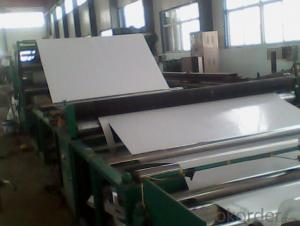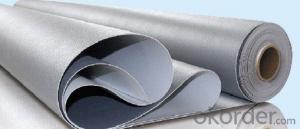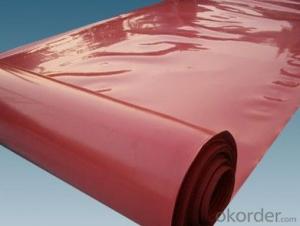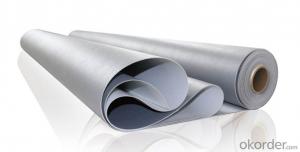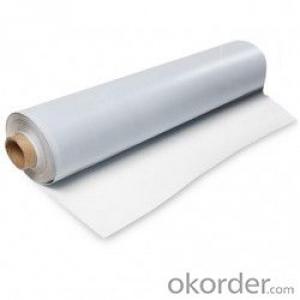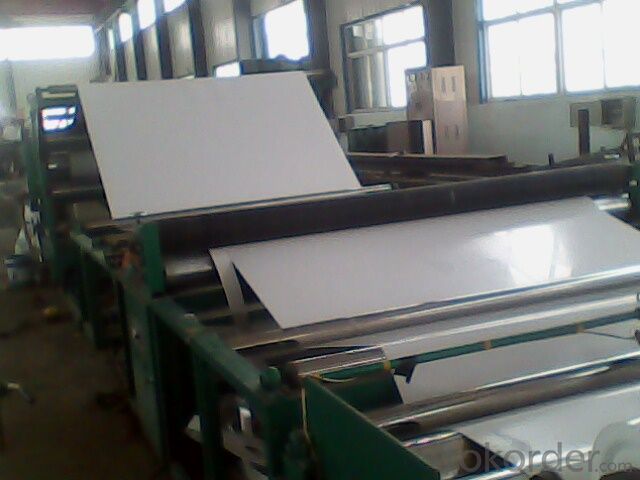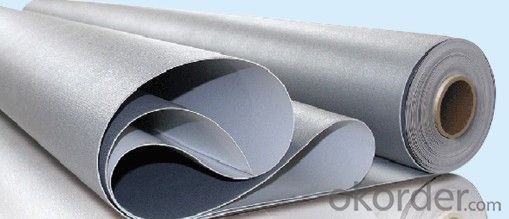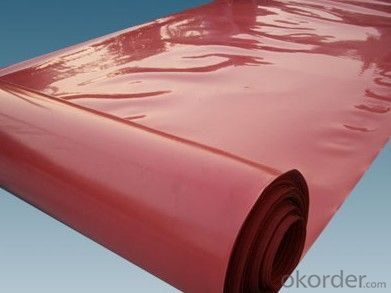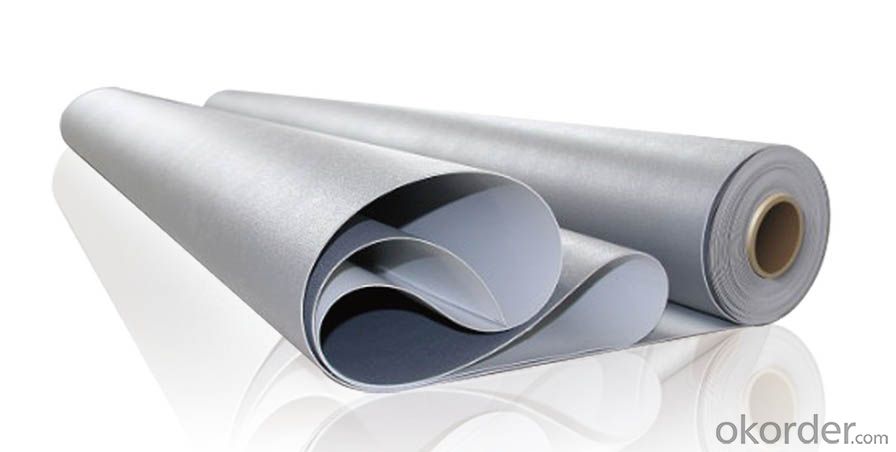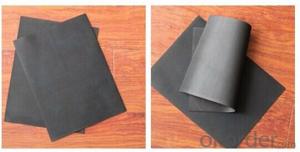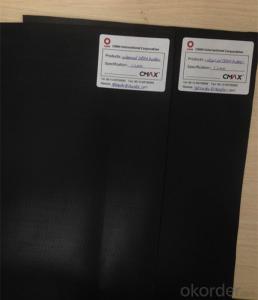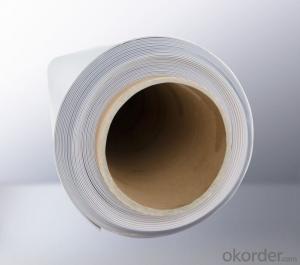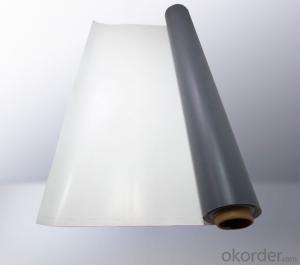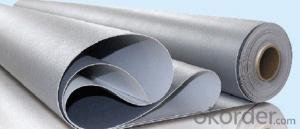Products Description of Thermoplastic Polyolefin (TPO) waterproof membrane
- Loading Port:
- Qingdao
- Payment Terms:
- TT or LC
- Min Order Qty:
- 20000 m²
- Supply Capability:
- 600000 m²/month
OKorder Service Pledge
OKorder Financial Service
You Might Also Like
Products Description of Thermoplastic Polyolefin (TPO) Waterproof Membrane:
The Thermoplastic Polyolefin (TPO) waterproof membranes are the most popular waterproof materials in the world at present. It’s thermoplastic elastomeric waterproof materials by adopting advanced polymerization together with squeeze technology,which perform well in mechanical properties, high tensile strength,oxidation-resistance and resistance to puncture.
Product Features of Thermoplastic Polyolefin (TPO) Waterproof Membrane:
1.High UV-resistance and high reflectivity
2. Excellent weathering characteristics and long-term flexibility
3.High tensile strength and puncture resistance
4. Excellent resistance to harsh chemicals and industrial pollutas
5.Heat or solvent-welding effectively provides seamless roof covering
TPO Physical Properties of Thermoplastic Polyolefin (TPO) Waterproof Membrane:
Item | Specification | |||||||
H | L | P | G | GL | ||||
The resin thickness of Middle fabric, mm≥ | — | 0.40 | ||||||
Maximum tension,N/cm ≥ | — | 200 | 250 | — | 200 | |||
Tension strength,Mpa≥ | 12 | 12 | ||||||
Maximum tension elongation,%≥ | 15 | |||||||
Fracture elongation,%≥ | 500 | 250 | 400 | 200 | ||||
Heat treatment size change rate %≤ | 2.0 | 1.0 | 0.5 | 0.1 | 0.1 | |||
Low temperature bend | -40°C No crack | |||||||
Water tightness | 0.3Mpa,2h, No seepage | |||||||
Attack resistance | 0.5kg·m,No seepage | |||||||
Static charge resistance | — | 20kg ,No seepage | ||||||
Seam strip strength ,N/mm≥ | 4.0 or Membranes break | 3.0 | ||||||
Right-angle tear strength,N/mm≥ | 60 | 60 | ||||||
Trapezoid tear strength N≥ | — | 300 | 450 | 350 | ||||
Bibulous rate (70°C 168h), % | After soaking≤ | 4.0 | ||||||
Air-cure later≥ | -0.40 | |||||||
Heat aging (115°C)
| Time | 672h | ||||||
Appearance | No blister,flaw,delamination,coherence,hole | |||||||
Tensile strength retention,%≥ | 90 | |||||||
Elongation rate of keeping,%≥ | 90 | |||||||
Low temperature bend | -40°C, No crack | |||||||
Chemistry resistance | Appearance | No blister,flaw,delamination,coherence,hole | ||||||
Tensile strength retention,%≥ | 90 | |||||||
Elongation rate of keeping,%≥ | 90 | |||||||
Low-temperature bending | -40°C, No crack | |||||||
Artificial weather accelerated aging | Time | 1500hb | ||||||
Appearance | No blister,flaw,delamination,coherence,hole | |||||||
Tensile strength retention%≥ | 90 | |||||||
Elongation rate of keeping%≥ | 90 | |||||||
Low temperature bend | -40°C ,No crack | |||||||
FRQ:
What is your main market?
Our Tpo Roofing Membrane with Superior Raw Material for Roofing Market sells very well in USA, United Kingdom, Austrilia, Canada, Japan, Pakistan, etc.
What is your advantage for Tpo Roofing Membrane?
With the most advanced production line, our good quality is based on superior material imported from America. We have different color available and could produce any color you want.
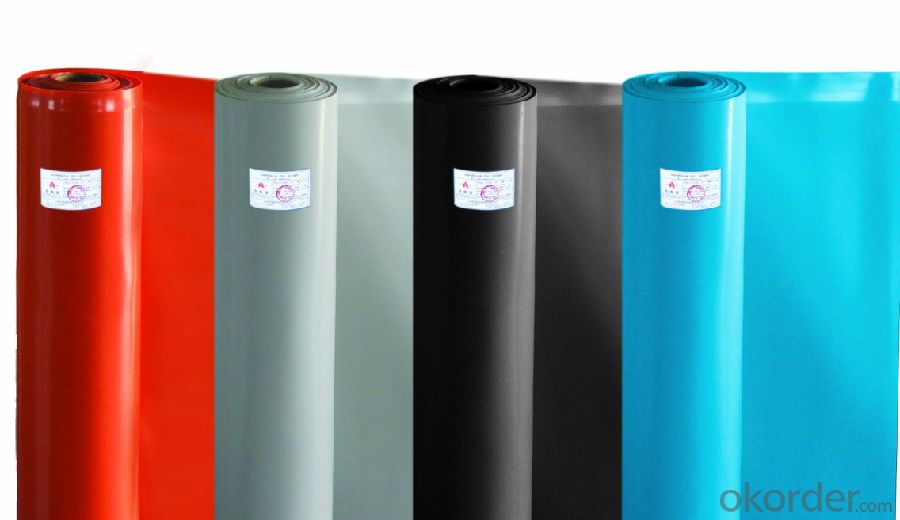
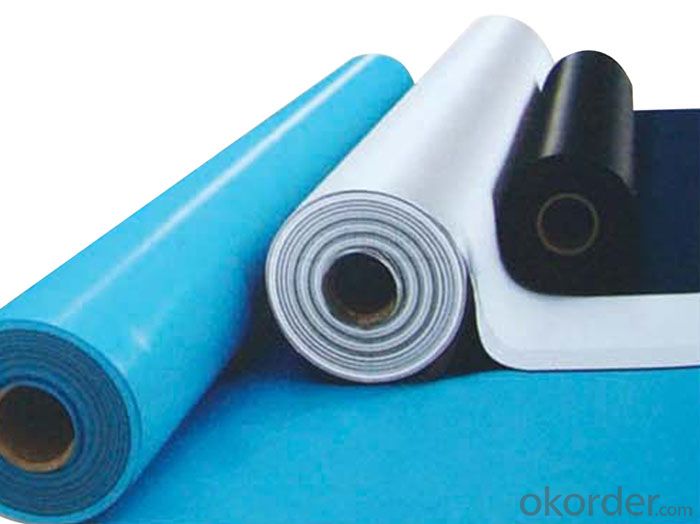
- Q: Can a waterproofing membrane be tiled over?
- Certainly, tiling over a waterproofing membrane is possible. Actually, it is strongly advised to incorporate a waterproofing membrane prior to tiling in areas susceptible to moisture, like bathrooms, showers, and outdoor patios. This membrane serves as a protective shield, preventing water from seeping through and safeguarding the underlying structure from harm. By placing tiles directly on the membrane, the durability and longevity of the tile installation are assured. It is crucial to adhere to the manufacturer's instructions and utilize suitable adhesives and grouts that harmonize with the waterproofing membrane to guarantee a triumphant and water-resistant tile installation.
- Q: Can a waterproofing membrane be used for bridge decks?
- Yes, a waterproofing membrane can be used for bridge decks. Bridge decks are exposed to various weather conditions, including rain, snow, and humidity, which can cause damage and deterioration over time. Therefore, applying a waterproofing membrane on the bridge deck surface can help protect it from water infiltration and moisture-related issues such as corrosion of steel reinforcements. Waterproofing membranes are specifically designed to create a barrier that prevents water from penetrating the surface. They are typically made from materials such as modified bitumen, thermoplastic, or liquid-applied coatings. These membranes are applied to the bridge deck surface, creating a seamless and watertight layer that prevents water from seeping into the deck structure. In addition to preventing water infiltration, waterproofing membranes can also provide additional benefits for bridge decks. They can help reduce the risk of freeze-thaw damage, protect against chemical attacks from de-icing salts or pollutants, and increase the overall durability and lifespan of the bridge deck. It is important to note that the selection of the appropriate waterproofing membrane for a bridge deck depends on various factors such as the type of bridge, traffic conditions, climate, and expected service life. Therefore, it is essential to consult with structural engineers and waterproofing specialists to choose the most suitable membrane system for a specific bridge deck project.
- Q: Can waterproofing membranes be used on bridge decks?
- Yes, waterproofing membranes can be used on bridge decks. Bridge decks are constantly exposed to harsh weather conditions, including rain, snow, and freeze-thaw cycles, which can lead to the deterioration of the concrete and steel reinforcement. Waterproofing membranes are designed to prevent water infiltration and protect the bridge deck from moisture-related damage. These membranes are typically made of flexible materials such as bitumen, PVC, or EPDM rubber, and they are applied directly onto the bridge deck surface. The waterproofing membrane acts as a barrier, preventing water from seeping into the concrete and causing corrosion of the reinforcement. It also helps to reduce the formation of cracks and extends the service life of the bridge deck. Additionally, waterproofing membranes can be combined with other protective coatings or systems to enhance their effectiveness and durability. Overall, the use of waterproofing membranes on bridge decks is a common and effective method to ensure the long-term integrity and functionality of the structure.
- Q: Can a waterproofing membrane be used for bridge abutments?
- Bridge abutments can be safeguarded using a waterproofing membrane. These membranes are commonly utilized in the construction industry to safeguard structures from moisture damage and prevent water infiltration. Due to their close proximity to water bodies and potential exposure to groundwater, bridge abutments are particularly at risk of water damage. The application of a waterproofing membrane on bridge abutments serves as a protective barrier against water penetration, effectively shielding the structure from potential harm. To ensure comprehensive protection, the membrane is typically installed on the abutment walls and extends below ground level. Waterproofing membranes are designed to be both durable and flexible, enabling them to withstand movement and settling that may occur in bridge abutments. Materials such as bitumen, PVC, or modified bitumen are commonly used to create these membranes, as they offer exceptional resistance to water and other environmental factors. By incorporating a waterproofing membrane on bridge abutments, engineers and contractors can guarantee the structure's longevity and safety. It effectively mitigates moisture-related issues, including concrete deterioration, corrosion of reinforcing steel, and the emergence of cracks and leaks. Furthermore, the membrane can serve as a vapor barrier, reducing the likelihood of condensation and moisture buildup within the abutments. In conclusion, waterproofing membranes provide an effective solution for safeguarding bridge abutments against water damage. They establish a dependable barrier against water penetration, ensuring the structural integrity and longevity of the bridge.
- Q: Can a waterproofing membrane be used on precast steel surfaces?
- Indeed, precast steel surfaces can benefit from the utilization of a waterproofing membrane. These membranes are specifically engineered to serve as a safeguard against water infiltration, making them suitable for various surfaces, including precast steel. By acting as a waterproof shield, the membrane effectively blocks water from penetrating the surface and causing any potential harm. It is imperative to ensure that the surface is adequately primed and sanitized prior to applying the membrane to ensure optimal adhesion and efficacy. Furthermore, seeking advice from a qualified waterproofing contractor is highly recommended in order to identify the most suitable membrane type and application technique for the specific precast steel surface.
- Q: Can a waterproofing membrane be used for warehouses or storage facilities?
- Warehouses or storage facilities can utilize a waterproofing membrane. These membranes are specifically designed to safeguard structures against water damage by creating a barrier that prevents moisture infiltration. In warehouses and storage facilities, there are often large areas that are vulnerable to potential leaks or seepage, such as roofs, walls, and floors. By installing a waterproofing membrane, these structures can be effectively shielded from water intrusion, thereby preventing harm to stored goods and maintaining the facility's integrity. Waterproofing membranes come in various types, including bituminous, liquid-applied, or sheet membranes, providing flexibility in selecting the most appropriate option based on the specific requirements of the warehouse or storage facility. Furthermore, waterproofing membranes offer additional advantages such as thermal insulation and resistance to chemicals, further enhancing their value in ensuring the durability and functionality of warehouses or storage facilities.
- Q: Can a waterproofing membrane be used in interior or exterior applications?
- Yes, a waterproofing membrane can be used in both interior and exterior applications. In interior applications, such as basements or bathrooms, a waterproofing membrane can be installed on walls or floors to prevent water or moisture from seeping through. This helps to protect the underlying structure from damage caused by water intrusion. In exterior applications, a waterproofing membrane can be applied to the exterior walls or foundations of a building to prevent water from penetrating into the structure. This is especially important in regions with heavy rainfall or high water tables. By creating a barrier against water, the membrane helps to keep the interior of the building dry and free from water damage. Overall, the use of a waterproofing membrane in both interior and exterior applications is essential for ensuring the longevity and durability of a structure by protecting it from water-related issues.
- Q: Can a waterproofing membrane be used in conjunction with flooring materials?
- Indeed, flooring materials can be used in conjunction with a waterproofing membrane. It is actually quite common to advise the application of a waterproofing membrane while installing specific types of flooring, particularly in wet spaces such as bathrooms, kitchens, or basements. The waterproofing membrane functions as a shield against moisture, effectively thwarting water penetration that could potentially harm the flooring material or the subfloor. It provides safeguard against leaks, spills, and even excessive moisture in the atmosphere. Through the utilization of a waterproofing membrane, you can guarantee the longevity and sturdiness of your flooring, simultaneously upholding a waterproof and moisture-resistant environment.
- Q: Are waterproofing membranes resistant to hydrostatic pressure?
- Yes, waterproofing membranes are designed to be resistant to hydrostatic pressure. Hydrostatic pressure refers to the pressure exerted by water when it is at rest. When a building is exposed to water from the ground, such as in basements or foundations, hydrostatic pressure can become a significant concern, as it can cause water to seep through the walls or floors. Waterproofing membranes are specifically engineered to withstand and resist the pressure exerted by water, ensuring that it does not penetrate into the building structure. These membranes are typically made from materials such as bitumen, rubberized asphalt, or synthetic polymers, which have excellent water resistance properties. Moreover, waterproofing membranes are designed to create a continuous barrier against water, preventing any potential leaks or seepage. They are applied in multiple layers, ensuring a strong and durable barrier that can withstand the high pressure exerted by water. It is important to note that the resistance to hydrostatic pressure may vary depending on the type and quality of the waterproofing membrane used. Therefore, it is crucial to choose a high-quality membrane and ensure proper installation to maximize its effectiveness in resisting hydrostatic pressure.
- Q: What are the advantages and disadvantages of waterproofing membrane?
- The waterproof membrane study its drawbacks: waterproofing is performed when the amount of coating material according to the cross-sectional shape of the waterproof base waterproof construction, the need for a complex shape of the base layer a plurality of splicing, waterproofing overlap each other at the bonding difficult than Large, due to the impact of multi-block splicing waterproof layer of beauty; then completely absolute seal will become the main problem, the biggest hidden dangers, the most opportunities is the coiled parts of the coil; then high-grade waterproofing membrane with a few decades durable for a long time, but the country is still less matched the binder, and the binder material itself due to environmental factors such as loss of adhesion is often ahead of function, thus leading to the failure of the waterproof self-evident; Furthermore Waterproof membrane after the construction of the protection and leakage after the maintenance is also a problem, exposed waterproof layer of foreign mechanical damage prevention is very important, waterproof membrane and the grass-roots bonding, whether full of shops, shop, shop air, between the base layer and the web would be to go aqueous layer, regardless of any part of the cross-cutting breakage, degumming, drooling (even the only one), the entire coherent thereto waterproof power level Will lose all bad, if you can not find damaged and defective parts, the local repair is not possible, then only redo waterproof layer.
Send your message to us
Products Description of Thermoplastic Polyolefin (TPO) waterproof membrane
- Loading Port:
- Qingdao
- Payment Terms:
- TT or LC
- Min Order Qty:
- 20000 m²
- Supply Capability:
- 600000 m²/month
OKorder Service Pledge
OKorder Financial Service
Similar products
Hot products
Hot Searches
Related keywords
